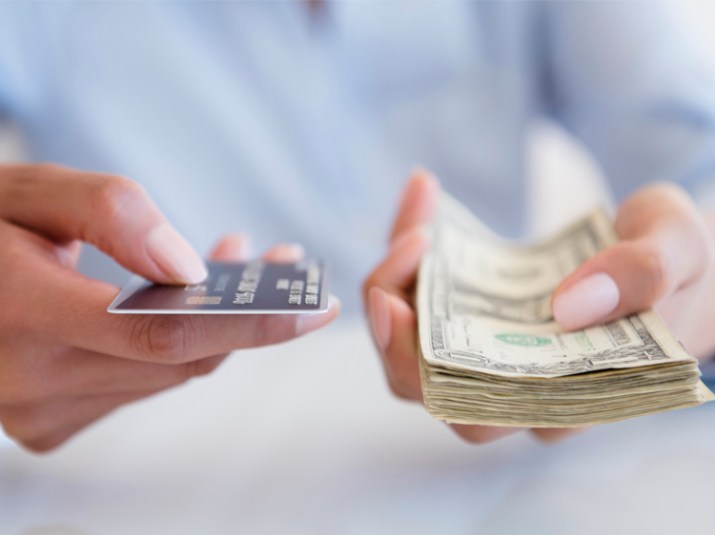The Best Way to Pay Off Credit Card Debt

If your nest egg isn’t where you’d like it to be, one of the best ways to boost your savings, financial experts say, is to erase your credit card debt so you aren’t throwing money away each month.
“When working on eliminating debt prior to retirement,” says Becky Krieger, CFP, CPA, Managing Director, Client and Community Outreach, Accredited Investors Wealth Management, “tackle credit card debt first since the interest in non-deductible.”
The rub? The average U.S. cardholder has a whopping 3.7 cards in his or her wallet. This can make starting to pay down debt confusing and difficult.
The upside is that with patience and diligence, paying off debt is an achievable goal no matter how much you owe.
1. Track your monthly costs.
First things first. In order to pay down your debt, you’ll have to put more than the minimum toward your balance. For many folks, this means taking a hard look at their spending and making cuts where they can.
Some monthly costs are non-negotiable. These include your mortgage, rent, insurance, utilities, and basic needs like gas and groceries. Unfixed costs are the ones you should focus on. These include dining out, movie and concert tickets, and trips to the mall.
“These are the hardest costs to cut but the first ones that can go when you’re trying to cut your spending,” says Jen Smith, personal finance expert at The Penny Hoarder.
The good news: “Not all of your unfixed costs have to go,” Smith continues. “Focus on the few you’re spending the most on and decrease your spending to a more reasonable amount over the span of a few months. This will keep you from the rebounding that happens when you go too hard too fast.”
2. Debt Snowball Vs. Debt Avalanche: Which is for you?
Once you’ve identified how much money you can set aside each month to put toward your debt, you need to figure out the most efficient way to do it. There are two schools of thought here:
Debt snowball. This method calls for paying off your smallest debt first, while also making the minimum monthly payments on your other cards. Once you’ve paid off your first card, you then earmark that money for the card with the next-smallest debt. This process repeats until all your cards are paid off. This works best for people who need the satisfaction of paying off a card in full first as opposed to managing the debt-load of several cards at once.
Debt avalanche. In this process, you’ll identify the card with the highest interest rate and pay it off first, in addition to paying the minimum monthly payments on your other cards. Once that card is paid off, you’ll start paying down the card with the second-highest interest rate, repeating the process until you are debt-free.
3. Consider a balance transfer.
Some folks are financially unable to make the cuts necessary to pay down their balance in due time.
For them, a balance transfer – or moving debt from one credit card to one with a lower interest rate — may make sense. Many balance transfers are made to credit cards with a 0 percent interest rate, allowing those with a heavy debt load to gain traction in paying it down without worrying about associated interest.
Sound too good to be true? It may be. With each new credit card account opened, your credit score may take a temporary dip until your credit history stabilizes. A balance transfer can also alter your credit utilization ratio, which is the amount of available credit you use each month. Experts typically recommend not allowing your credit utilization to go above 30 to 40 percent of both your individual cards and the total of your cards combined. One way to help achieve this is to keep the account from which you are transferring your balance open, if possible.
“Be aware there are usually fees associated with the initial transfer and that zero percent interest rate goes away,” says Smith. “You need to have a plan for paying your debt off fast if you’re going to truly benefit from one.”
4. Look into a debt management program.
Some folks find their debt so overwhelming that they turn to non-profit credit counseling agencies to help then pay it down by agreeing to a multi-year consolidated debt-management plan.
There are pros and cons to this arrangement. In addition to cutting your interest rate, your debt will be more manageable since you’ll be making only one monthly payment, not juggling two or more. However, you won’t be able to use your credit cards or apply for new ones while on the plan. What’s more, if you miss a payment your interest rate may rise.
Smith stresses that once your debt is paid off, you should focus on building up an emergency fund. That’s because unplanned expenses, including those associated with a job loss, unexpected travel, auto and home repairs, and medical or dental needs can quickly eat up your available credit if you use your card to pay for them. By having more savings socked away, you can cover these expenses without incurring debt.
“Having an emergency fund is the best way to stay out of credit card debt,” she says. “Our brains are much more motivated to build our savings back up after draining it than we are to make credit card payments. So even a small emergency fund is better than a credit card kept around ‘for emergencies.’”
More From FIRST
4 Money Matters That Couples Should Agree On
















